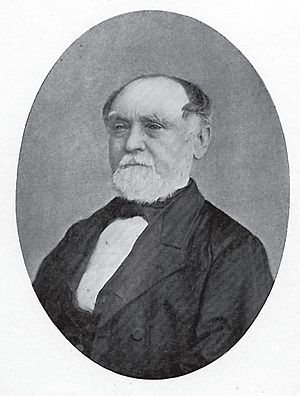Friedrich Adolph Wislizenus facts for kids
Quick facts for kids
Friedrich Adolph Wislizenus
|
|
|---|---|
 |
|
| Born | May 21, 1810 Königsee, Germany
|
| Died | September 23, 1889 (aged 79) St. Louis, Missouri, United States
|
| Nationality | German |
| Citizenship | American |
| Education | University of Tübingen, University of Göttingen |
| Alma mater | University of Jena |
| Occupation | Botanist, MD |
| Years active | 1835–1889 |
| Spouse(s) | Lucy Crane (1850–1889) |
| Children | 5 |
| Parent(s) | Johann C. A. Wislizenus Margaretha Beck |
Friedrich Adolph Wislizenus (sometimes called Frederick) was a doctor, explorer, and plant expert. He was born in Germany on May 21, 1810, and later became an American citizen. He is famous for writing about his exciting trips to places like Northern Mexico and what is now New Mexico. He passed away on September 23, 1889.
Contents
The Life of Friedrich Wislizenus
Early Years and Education
Friedrich Adolph Wislizenus was born on May 21, 1810, in Königsee, Germany. He was the youngest of three children. His parents, Johann Christian Anton Wislizenus and Margaretha Beck, sadly died when he was young. This happened during an epidemic brought by Napoleon's soldiers. His mother's brother, Dr. Hoffman, then took care of the orphaned children.
Young Friedrich first studied to become a clergyman. But he was more interested in science. He decided to study medicine instead. He attended several universities, including the University of Jena, University of Tübingen, and University of Göttingen.
A New Start in America
In 1833, Friedrich was involved in a failed attempt to change the government in Germany. This event was called the Frankfurter Wachensturm. Many of his friends were arrested, but Friedrich managed to escape. He left Germany and went to Zürich, Switzerland.
He graduated in 1834. After looking for work in Paris without success, he decided to sail to New York. He spent two years there, learning English and getting to know the country. He also wrote articles and poems.
Adventures in the American West
In 1837, Friedrich moved to St. Clair County, Illinois, where he worked as a doctor. But he found country life a bit boring. So, in 1839, he moved to St. Louis. There, he found a chance for adventure.
He joined an expedition with the Rocky Mountain Fur Company. He traveled far into the Northwest, exploring places like the Green River and the Wind River Mountains. When the fur trappers returned home, Wislizenus joined some Flathead and Nez Perce Indians. He crossed the Rocky Mountains with them. He wanted to cross the Sierra Nevada, but no guide would take him. So, he traveled back along the Arkansas River to the border of Missouri. This first big trip was mostly for fun, as he didn't have the right tools for scientific study.
Exploring Mexico and Sharing Discoveries
After returning to St. Louis in 1840, he went back to being a doctor. He also became active in the growing city. He often attended meetings at the Western Academy of Natural Sciences. There, he worked with his friend, George Engelmann, who was also a scientist.
In 1846, Friedrich's desire for exploration grew strong again. He joined a group of merchants traveling to Santa Fe. This time, he was much better prepared. When they reached Santa Fe, news of the Mexican–American War broke out. Despite the war, Wislizenus managed to cross the border into Chihuahua, Mexico. His group was then imprisoned in a mountain village for several months.
During his time as a prisoner, he took many notes. He made observations and sketches about northern Mexico. In the spring of 1847, Colonel Alexander William Doniphan freed the prisoners. Friedrich Adolph then returned to St. Louis.
Publishing His Travels
A senator named Thomas H. Benton heard about Wislizenus's travels. He asked Friedrich to publish his notes. So, Friedrich wrote a book called Memoir of a Tour to Northern Mexico in 1846 and 1847 by A. Wislizenus, M.D. This book corrected many wrong ideas about the western lands. It gave detailed descriptions, maps, and sketches of the areas near the Rio Grande. The Senate ordered 5,000 copies of the book to be printed and shared.
Friedrich brought back many new plants from his trip. Dr. George Engelmann studied these plants. To thank his explorer friend, Engelmann named some of the plants after Wislizenus. One example is Wislizenia refracta.
Later Life and Legacy
While working on his book, Wislizenus met Lucy Crane, who would become his wife. She was the sister-in-law of George Perkins Marsh, an important American diplomat.
In 1849, he returned to St. Louis. He worked hard to help people during a serious outbreak of cholera. Once the sickness ended, he traveled to Istanbul, Turkey. There, he married Lucy at the American Embassy on July 23, 1850. After visiting his hometown in Thuringia and some old cities in Europe, the couple returned to the USA.
After a short trip to Panama and the Pacific Coast, Wislizenus settled in St. Louis in 1852. He stayed there for the rest of his life, except for short trips. He continued his scientific interests. He helped start the St. Louis Academy of Science. He also studied weather and plants. Sadly, his eyesight failed, and he became completely blind a few years before he died. But he always had people read to him to keep his mind active.
Friedrich Adolph Wislizenus passed away on September 23, 1889. He left behind a rich collection of scientific knowledge and observations.
Wislizenus is remembered in the scientific name of a North American lizard. It is called Gambelia wislizenii.

